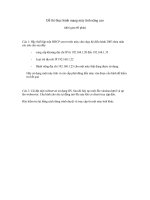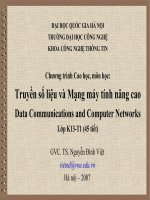Slide mạng máy tính nâng cao chapter6 the transport layer
Bạn đang xem bản rút gọn của tài liệu. Xem và tải ngay bản đầy đủ của tài liệu tại đây (5.42 MB, 66 trang )
Chapter 6
The Transport Layer
CuuDuongThanCong.com
/>
The Transport Service
•
•
•
•
Services Provided to the Upper Layers
Transport Service Primitives
Berkeley Sockets
An Example of Socket Programming:
–
An Internet File Server
CuuDuongThanCong.com
/>
Services Provided to the Upper Layers
The network, transport, and application layers.
CuuDuongThanCong.com
/>
Transport Service Primitives
The primitives for a simple transport service.
CuuDuongThanCong.com
/>
Transport Service Primitives (2)
The nesting of TPDUs, packets, and frames.
CuuDuongThanCong.com
/>
Transport Service Primitives (3)
A state diagram for a simple connection management scheme.
Transitions labeled in italics are caused by packet arrivals. The
solid lines show the client's state sequence. The dashed lines show
the server's state sequence.
CuuDuongThanCong.com
/>
Berkeley Sockets
The socket primitives for TCP.
CuuDuongThanCong.com
/>
Socket
Programming
Example:
Internet File
Server
6-6-1
Client code using
sockets.
CuuDuongThanCong.com
/>
Socket
Programming
Example:
Internet File
Server (2)
Client code using
sockets.
CuuDuongThanCong.com
/>
Elements of Transport Protocols
•
•
•
•
•
•
Addressing
Connection Establishment
Connection Release
Flow Control and Buffering
Multiplexing
Crash Recovery
CuuDuongThanCong.com
/>
Transport Protocol
(a) Environment of the data link layer.
(b) Environment of the transport layer.
CuuDuongThanCong.com
/>
Addressing
TSAPs, NSAPs and transport connections.
CuuDuongThanCong.com
/>
Connection Establishment
How a user process in host 1 establishes a connection
with a time-of-day server in host 2.
CuuDuongThanCong.com
/>
Connection Establishment (2)
(a) TPDUs may not enter the forbidden region.
(b) The resynchronization problem.
CuuDuongThanCong.com
/>
Connection Establishment (3)
Three protocol scenarios for establishing a connection using a
three-way handshake. CR denotes CONNECTION REQUEST.
(a) Normal operation,
(b) Old CONNECTION REQUEST appearing out of nowhere.
(c) Duplicate CONNECTION REQUEST and duplicate ACK.
CuuDuongThanCong.com
/>
Connection Release
Abrupt disconnection with loss of data.
CuuDuongThanCong.com
/>
Connection Release (2)
The two-army problem.
CuuDuongThanCong.com
/>
Connection Release (3)
6-14, a, b
Four protocol scenarios for releasing a connection. (a) Normal case of a
three-way handshake. (b) final ACK lost.
CuuDuongThanCong.com
/>
Connection Release (4)
6-14, c,d
(c) Response lost. (d) Response lost and subsequent DRs lost.
CuuDuongThanCong.com
/>
Flow Control and Buffering
(a) Chained fixed-size buffers. (b) Chained variable-sized buffers.
(c) One large circular buffer per connection.
CuuDuongThanCong.com
/>
Flow Control and Buffering (2)
Dynamic buffer allocation. The arrows show the direction of
transmission. An ellipsis (…) indicates a lost TPDU.
CuuDuongThanCong.com
/>
Multiplexing
(a) Upward multiplexing. (b) Downward multiplexing.
CuuDuongThanCong.com
/>
Crash Recovery
Different combinations of client and server strategy.
CuuDuongThanCong.com
/>
A Simple Transport Protocol
• The Example Service Primitives
• The Example Transport Entity
• The Example as a Finite State Machine
CuuDuongThanCong.com
/>
The Example Transport Entity
The network layer packets used in our example.
CuuDuongThanCong.com
/>









